Enjoy Busan
The Blue Dragon arises after 60 years
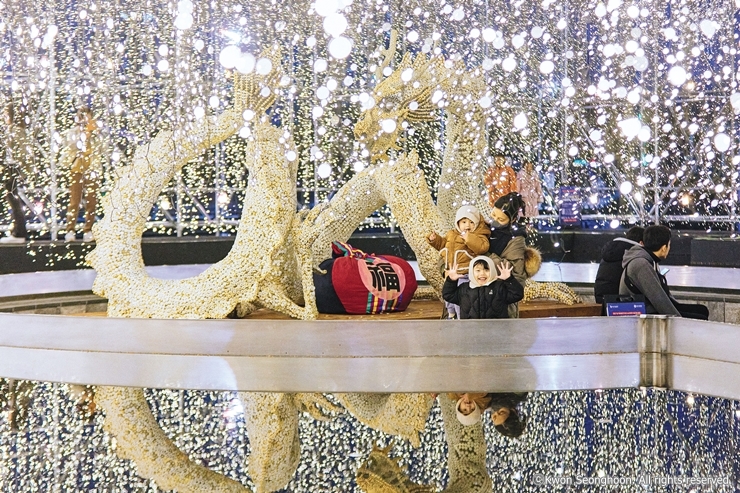시민공원2_권성훈_CW35.jpg&fileext=jpg&filetype=image/jpeg&filesize=489585)
The Golden Dragon installed at Busan Citizens Park, erected to honor the Year of the Blue Dragon, attracts passersby with its shimmering lights and intricate handcrafted details.
If you live anywhere on the peninsula, you'll undoubtedly have seen that 2024 is the Year of the Blue Dragon. Blue dragons are everywhere, from drone shows depicting a blue serpentine beast dancing in the sky to coffee drinks topped with blue foam. But why? The answer lies in the heavens.
First, Korea, like other Asian nations, still categorizes years based on the lunar calendar and a 12-year zodiac cycle, with a different animal - rat, ox, tiger, rabbit, dragon, snake, horse, goat, monkey, rooster, dog and pig - representing each year.
The animals are not merely mascots; each symbolizes certain traits and characteristics bestowed upon people born in that year. Koreans call this system "tti," similar to how Westerners might refer to one's zodiac sign.
A common question Koreans might ask you is, "What's your tti?" and then explain how you either perfectly match or are entirely different from the specific characteristics assigned to your birth year. Rat tti are attentive and witty, but can also be timid and cautious of others; dog tti are candid and warmhearted. Dragon tti are charismatic, confident and strong-willed.
So we have the dragon part. Why is it blue? The colors come from the sexagenary cycle. Also called Stems-and-Branches, the cycle is a historical method of recording time in China and other East Asian countries. Under the schema, each year is marked with one of the Ten Heavenly Stems and one of the Twelve Earthly Branches. Combined, they form 60 unique pairs, resulting in a 60-year cycle.
The Branches we know as the animal-based zodiac system discussed above. The Stems are characters associated with one of five elements - wood, fire, earth, metal and water - and a yin or yang polarity. The first year in the cycle is "Gap Ja" or "Wood Rat."
2024 is a "Gap Jin" year, where "Gap" (甲) refers to the Stem element of wood, which is associated with the color blue; "Jin" (辰) refers to the Branch symbol of the dragon. Hence, "Gap Jin" is the Year of the Blue Dragon (Azure would be more accurate to be honest).
In Korean folklore, "Cheongryong," or the Blue Dragon, held a sacred status, with ancient people believing it wielded control over the weather. The dragon's majestic nature made it a natural symbol for royalty, further imbuing it with notions of prosperity and power.
In 2024, tap into your Blue Dragon energy by visiting some of the "dragon lairs" located throughout Busan.
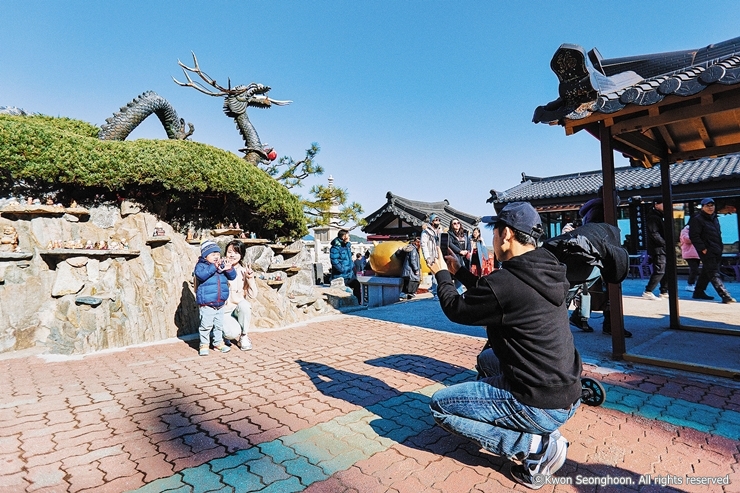
Haedong Yonggungsa is a great place to take little ones.
■ Pray to the Sea Dragon
Most Korean temples are carved into the side of a mountain or planted deep in a forest. However, Haedong Yonggugsa was built right into cliffs and rocks overlooking the sea.
Legend has it that a monk named Naong established the temple in 1376 after receiving a vision from the Great Goddess Buddha of Mercy, who lived alone at sea and appeared on the back of a dragon. In the vision, the Goddess told Naong to build a temple at the edge of Bongrae Mountain. When Naong visited the area, he noticed the eventual temple site would have a mountain in front and the ocean behind it, which meant that prayers said in the morning would be answered in the evening.
Naong's temple was destroyed by a fire when the Japanese invaded Korea. It was rebuilt in the 1930s. Later, a monk named Jungam prayed to the Great Goddess Buddha of Mercy, and she appeared to him on the back of a dragon. Jungam called the site Haedong Yonggungsa, or Temple of the Sea Dragon. When viewed from above, the surrounding mountain and cliffside look like a dragon lying on its belly, cradling the temple as if protecting a valued treasure.
The temple's motto is "At least one of your wishes will be answered here through your heartful prayers." As such, visitors flock to the temple, carrying their hopes and aspirations. After praying and tossing a coin into a fountain for good luck, they can find peace in the scenic blue sea and the sounds of waves crashing below.
While it may feel on the world's edge, the temple is only a 10-20 minute walk away from tourist attractions like Lotte World Adventure, Skyline Luge, and the world-class shopping at Lotte Premium Outlet.
-Address: 86 Yonggung-gil, Gijang-eup, Gijang-gun
-Hours: Open year-round, 4:30 am to 7 p.m.
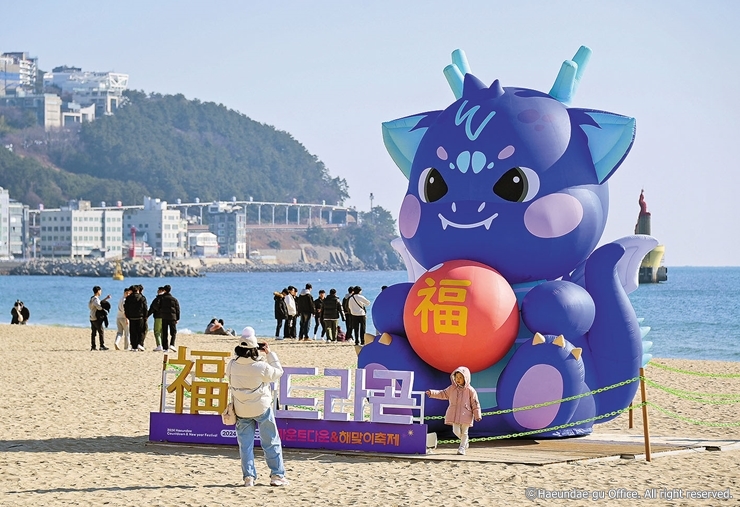
A baby dragon welcomes all to Haeundae Beach.
■ Snap a hatchling
Each year, Haeundae Beach decorates the shore with figures of the current zodiac animal. These days, a blue dragon takes the stage. A baby dragon clutching a red lucky pouch greets visitors, making it an irresistible photo spot. For those seeking a quieter ambiance, Songjeong Beach offers a calm setting in which to appreciate the winter ocean and greet a blue dragon character.
-Haeundae Beach: 264 Haeundaehaebyeon-ro Haeundae-gu
-Songjeong Beach: 712-2 Songjeong-dong, Haeundae-gu
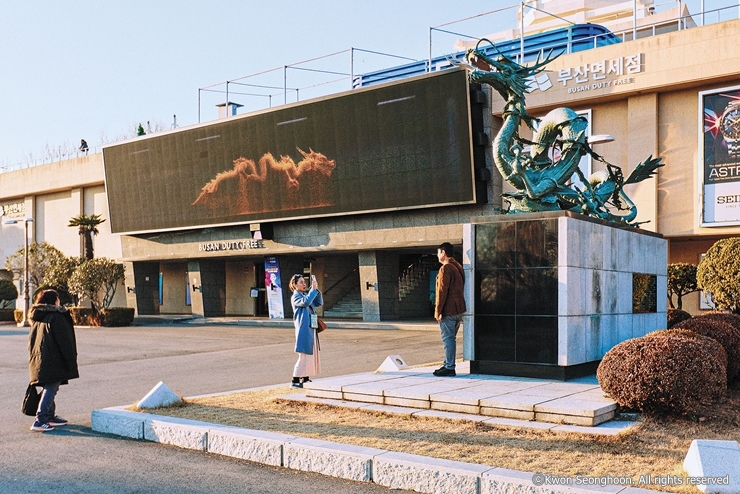
The soaring dragon is a popular photo spot at Yongdusan Park.
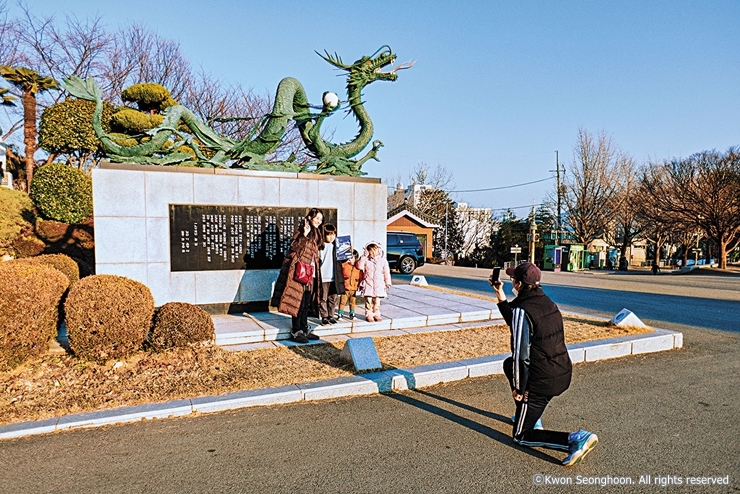
The dragon at Yongdusan Park.
■ Climb a dragon's head
Yongdusan Park stands atop Yongdusan Mountain, one of Busan's three mountains. The name "Yongdusan" is a combination of "yongdu," meaning "dragon's head," and "san," which translates to "mountain," referencing the mountain's shape.
The park resides in one of Busan's busiest neighborhoods, Nampo-dong. Despite this, a short walk from the bustling city center leads to a peaceful atmosphere within the park.
While journeying towards the Busan Diamond Tower within the park, visitors encounter a dragon sculpture grasping a white marble and gazing into the sky. According to Buddhist tales, whoever possesses the white marble will have their wishes come true and their misfortune cast away.
-Address: 37-55 Yongdusan-gil, Jung-gu
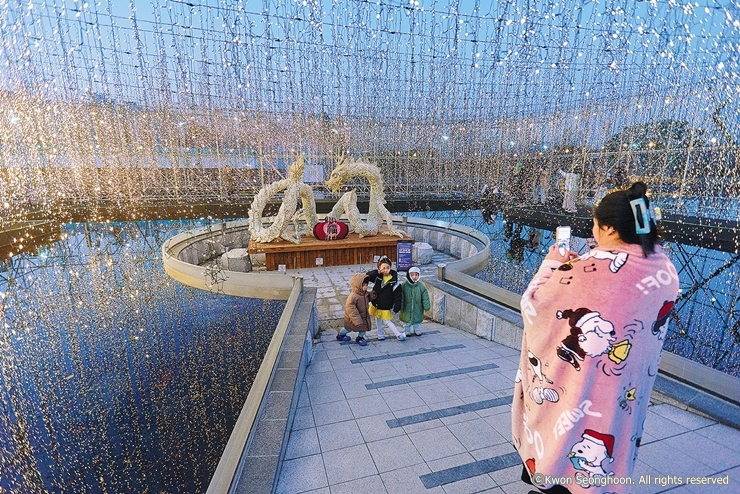
It is hard not to smile in front of the dragon at Busan Citizens Park.
■ Peep a dragon hoard
Once a military base, Busan Citizens Park transformed into a family-friendly greenspace in 2014. Now the park is home to a majestic Gold Dragon.
Located at the Mirror Pond, the Gold Dragon is a 4-meter by 3-meter structure adorned with handcrafted golden scales. Surrounded by 360,000 dazzling lights, the dragon is a captivating sight.
The lights are on from 5:30 to 11:30 p.m. daily until Feb. 25.
-Address: 73 Simingongwon-ro Busanjin-gu

